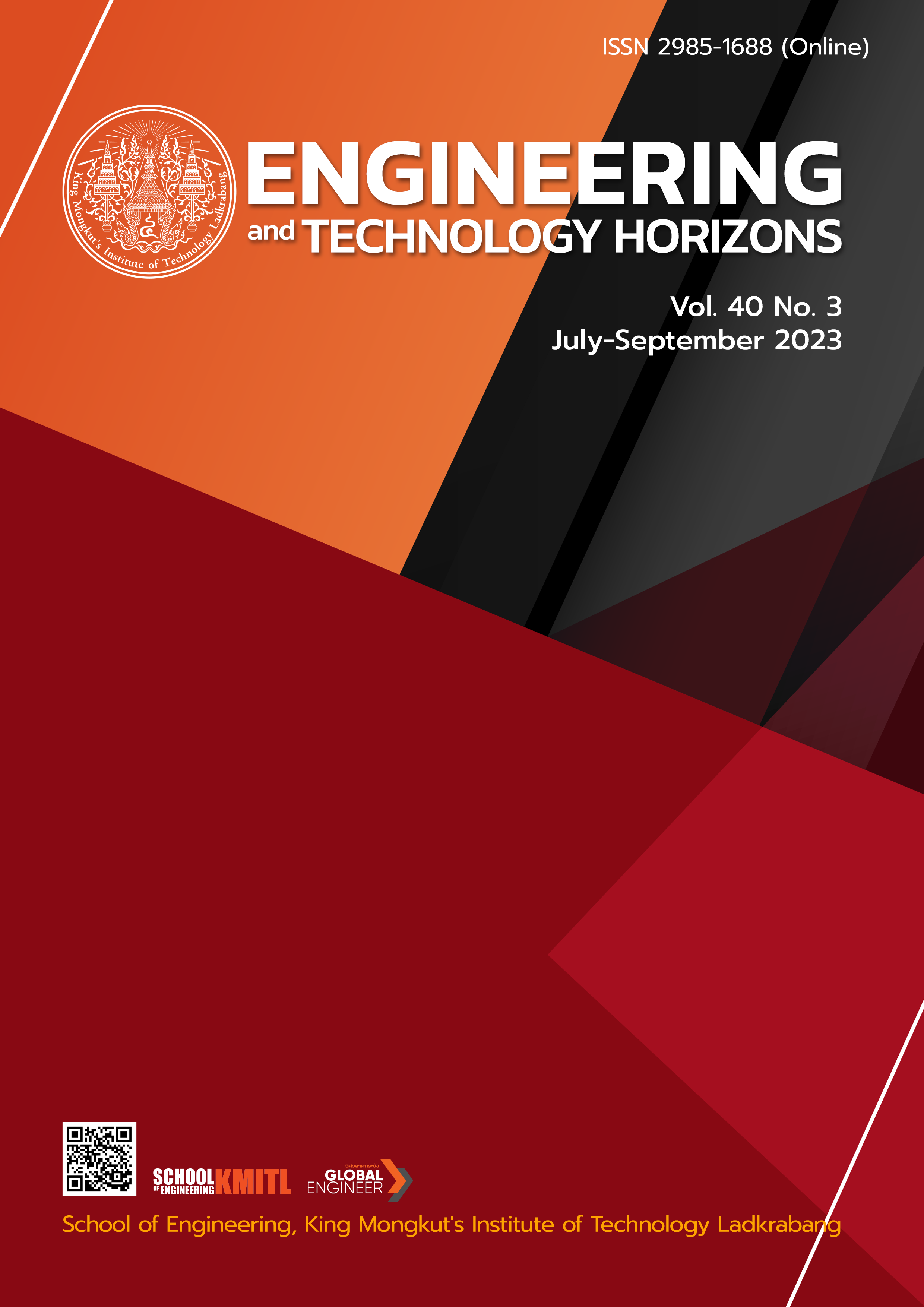Testing and Analysis of a Small-scale Cricket Housing Model under Standard of Good Agricultural Practices
Keywords:
Composite material, Internet of Things, Model, Cricket Housing, Standard of Good Agricultural PracticesAbstract
This research aims to test and analyze a model of cricket housing units according to good agricultural practices standards. The study assessed the composite sandwich panels used for the walls of cricket housing units and analyzed five distinct materials mixed within the panels: (1) air space, (2) foam sheets, (3) a mixture of 50% sawdust and 50% polyurethane foam, (4) a mixture of 75% sawdust and 25% polyurethane foam, and (5) a mixture of 100% sawdust. The experimental results showed that the most suitable material was the sawdust material mixed with 25% foam, which provided a penetration resistance of 282.71 N, a water absorption capacity of 37.90%, and a thermal conductivity of 0.65 W/m.K. For the field test, the composite panel offered similar experimental results as industrial sandwich panels. Furthermore, when the internet of things was used to regulate the environment inside the housing unit, the mean absolute percentage error between the internet of things and the wired system was less than 4.20%. Therefore, the findings on the mixed material panels and the environmental control system can be implemented in real-world applications.
References
Good Agricultural Practices for Cricket Farm, TAS. 8202-2017, National Bureau of Agricultural Commodity and Food Standards Ministry of Agriculture and Cooperatives, Bangkok, Thailand, Nov. 28, 2017. (in Thai)
N. Thomee, “cricket enemies” National Institute of Animal Health, vol. 20 no. 2, 2020, pp. 1–4. (in Thai)
C. D. Muscat-Fenech, J. Cortis and C. Cassar, “Impact damage testing on composite marine sandwich panels, part 1: Quasi-static indentation,” Journal of Sandwich Structures and Materials, vol. 16, no.4, pp. 341–376, 2014, doi: 10.1177/109963621452995.
E. Ferede, “Evaluation of Mechanical and Water Absorption Properties of Alkaline-Treated Sawdust-Reinforced Polypropylene Composite,” Journal of Engineering, vol. 2020, 2020, Art. no. 3706176, doi: 10.1155/2020/3706176.
J. T. Teng Teng, M. Y. Yaakob, M. Amirhafizan Bin Husin, K. A. Mohamed, M. Yuzrina and W. Lau, “Flexural and Out-of-Plane Compression Performance of Hexagonal Rubber Wood Core Sandwich with Increasing Cell Wall Thickness”. Manufacturing Technology, vol. 22, no.2, pp.240–253, 2022, doi: 10.21062/mft.2022.023.
S. A. Hafed, “Study of thermal insulation and some mechanical properties for hybrid composites (cement – wood sawdust),” International Journal of Computation and Applied Sciences, vol. 3, no.2, pp. 212–216, 2017.
Z. Buliński, S. Pawlak, T. Krysiński, W. Adamczyk and R. Białecki, “Application of the ASTM D5470 standard test method for thermal conductivity measurements of high thermal conductive materials,” Journal of Achievements in Materials and Manufacturing Engineering, vol. 95, no.2, pp.57–63, 2019, doi: 10.5604/01.3001.0013.7915.
R. O. Hegarty, A. Reilly, R. West and O. Kinname, “Thermal investigation of thin precast concrete sandwich panels,” Journal of Building Engineering, vol. 27, 2020, Art. no. 100937, doi: 10.1016/j.jobe.2019.100937.
M. Charaia, H. Sghiouri, A. Mezrhab, M. Karkri, K. Elhammouti and H. Nasri, “Thermal Performance and Characterization of a Sawdust-Clay Composite Material,” Procedia Manufacturing, vol.46, pp. 690–697, 2020, doi: 10.1016/j.promfg.2020.03.098.
Z. Zhao, X. Yang, X. Qu, J. Zheng and F. Mai, “Thermal insulation performance evaluation of autoclaved aerated concrete panels and sandwich panels based on temperature fields: Experiments and simulations,” Construction and Building Materials, vol. 303, 2021, Art. no. 124560, doi: 10.1016/j.conbuildmat.2021.124560.
J. R. Dutra, S. L. M. R. Filho, A. Christoforo, T. Panzera and F. Scarpa, “Investigations on sustainable honeycomb sandwich panels containing eucalyptus sawdust, Piassava and cement particles,” Thin-Walled Structures, vol. 143, 2019, Art. no. 106191, doi: 10.1016/j.tws.2019.106191.
K. Kanjanawanishkul, J. Kaewsihawong, W. Uttaracha and S. Yangyuen, “Smart Cricket Farming Based on Internet of Things,” Farm Engineering and Automation Technology Journal, vol. 6, no. 2, pp. 98–112, 2020. (in Thai)
K. Sureeya and T. Inthasuth, “Packet Traffic Measurement of IEEE1888 WRITE Procedure between ZigBee Gateway and Storage for Building Energy Management System,” presented at 34th International Technical Conference on Circuits/Systems, Computers and Communications (ITC-CSCC), Jeju, South Korea, Jun. 23–26, 2019, pp. 1–4, doi: 10.1109/ITC-CSCC.2019.8793437.
W. Anupan, S. Nunsong, B. Yotsavip, W. Boonsong, S. Somwong and T. Inthasuth, “Development and Accuracy Analysis of Embedded Based Instrumentation Toward ZigBee and NB-IoT Networks for Efficiency Energy Applications,” presented at 2023 International Conference on Electronics, Information, and Communication (ICEIC), Singapore, Nov. 27–28, 2023, pp. 1–4, doi: 10.1109/ICEIC57457.2023.10049870.
B. C. Olaiya, M. M. Lawan and K. A. Olonade, “Utilization of sawdust composites in construction—a review,” SN Applied Sciences, vol. 5, 2023, Art. no. 140, doi: 10.1007/s42452-023-05361-4.
D. Nield and A. Bejan, “Heat Transfer through a Porous Medium,” in Convection in Porous Media, New York, NY, USA: Springer, 2006, ch. 2, sec. 2.2.3, pp. 33–36.
Methods of testing to determine the thermal performance of unglazed flat-plate liquid-type solar collectors, ANSI/ASHRAE 96-1980 (RA 1989), American National Standards Institute, New York, NY, USA, 1989. [Online] Available: https://webstore.ansi.org/standards/ashrae/ansiashrae961980ra1989
Downloads
Published
How to Cite
Issue
Section
License
Copyright (c) 2023 Faculty of Engineering, King Mongkut’s Institute of Technology Ladkrabang

This work is licensed under a Creative Commons Attribution-NonCommercial-NoDerivatives 4.0 International License.
The published articles are copyrighted by the School of Engineering, King Mongkut's Institute of Technology Ladkrabang.
The statements contained in each article in this academic journal are the personal opinions of each author and are not related to King Mongkut's Institute of Technology Ladkrabang and other faculty members in the institute.
Responsibility for all elements of each article belongs to each author; If there are any mistakes, each author is solely responsible for his own articles.






